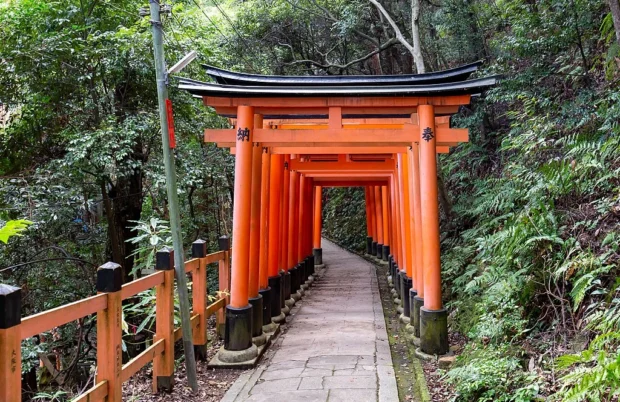Situated in the historic city of Kyoto, Japan, the Fushimi Inari Shrine captivates visitors with its endless rows of vibrant orange torii gates, winding trails, and rich cultural heritage. Known for its unique architecture and deep-rooted spiritual significance, this shrine offers an enchanting journey blending nature, tradition, and history. Whether you arrive from Kyoto Station, the airport, or nearby accommodations, the shrine’s atmosphere has something for every curious traveler who seeks to understand Japan’s ancient rituals and the artistry of Shinto craftsmanship.
Table of Contents
Walking Through the Gates: The Shrine’s Symbolism and History
Fushimi Inari Shrine stands as the head shrine of Inari, the Shinto god of rice, prosperity, and industry. Founded in 711 AD, it has grown into a symbol of success and protection for businesses and farmers alike. The thousands of vermilion torii gates, known as senbon torii, are donations from worshippers and companies seeking divine blessings. Each gate is inscribed with the donor’s name and date, reflecting a tradition that has continued for centuries.
One fascinating local tale tells of foxes, considered messengers of Inari. Statues of foxes with a key in their mouths can be found throughout the shrine grounds, symbolizing the guardian of the granaries. These cunning creatures bring a mystical aura and remind visitors of Japan’s respect for nature and spirituality intertwined.
Best Time and Day to Visit Fushimi Inari Shrine
To fully immerse yourself in the serene charm of Fushimi Inari Shrine, early mornings are ideal. Arriving just after sunrise lets you avoid the large crowds and witness soft light filtering through the distinctive torii, creating a tranquil and almost otherworldly ambiance. Weekdays, particularly Tuesday through Thursday, tend to be less busy, offering more room for reflection and photography.
During the New Year’s celebrations, the shrine becomes exceptionally popular as locals pray for good fortune in the coming year. Although the atmosphere during these festivals is vibrant and culturally rich, visitors seeking a peaceful atmosphere may prefer quieter seasons like late autumn, when the crisp air adds a fresh layer of beauty to the woodland paths.
How to Reach Fushimi Inari: Practical Directions and Transport
The most convenient way to reach Fushimi Inari Shrine is by train. From Kyoto Station, the JR Nara Line provides a direct route to Inari Station, which is just a short walk from the shrine’s entrance. The ride takes about 5 minutes, making it accessible even for a half-day trip.
For travelers arriving via Kansai International Airport, learning about Osaka’s landmarks, food, and transport can help plan smooth connections and tasty stops nearby.
If you arrive by air at Kansai International Airport, you can take the JR Haruka Express to Kyoto Station and then transfer to the JR Nara Line. Alternatively, local buses connect Kyoto Station with various parts of the city, though trains remain faster and more comfortable.
For accommodation, tone down the usual hotel buzz by choosing guesthouses or inns in the Fushimi or southern Kyoto area. These spots bring you closer to local life and provide easy access to authentic dining experiences such as inari sushi at neighborhood eateries, where you can savor the sweet and salty flavors wrapped in deep-fried tofu-a local specialty inspired by the shrine’s fox deity.
Exploring the Trails and Architectural Highlights
Begin your journey at the main shrine area, where traditional buildings display classic wooden craftsmanship and intricate Shinto designs. As you enter the famous torii-lined trails, notice how the gates create a tunnel of color and shadow, lifting your spirit with every step. The hike to the summit takes roughly two hours, with several smaller shrines, scenic viewpoints, and rest spots along the way.
Many visitors miss the Go-o Shrine midway up the mountain, known for its stone fox statues wearing red bibs, believed to bring protection. The winding path also offers peaceful moments to sit and absorb the natural surroundings, which include ancient cedar trees and moss-covered stones inviting quiet contemplation.
For a wider view of Kyoto’s rich culture and charming spots beyond the shrine, visit Discover Kyoto’s Charm: Landmarks, Food, and Culture to Enjoy.
Guided Tours and Reservations: Planning Your Shrine Visit
Fushimi Inari Shrine welcomes visitors without requiring reservations, making it easy to explore at your own pace. However, if you prefer deeper insight, local guides offer tours that explain the shrine’s cultural context, symbolism, and folklore. Some tours combine visits to nearby bamboo forests or traditional tea houses, providing a fuller cultural experience.
Booking these tours online ahead of time is recommended during peak seasons to guarantee availability. Small group tours tend to be more personal and interactive, ideal for travelers who appreciate storytelling and detailed explanations about craft and ritual.
Taste of Tradition: Nearby Food and Local Specialties
After your shrine walk, delight your senses at local stalls and eateries near Fushimi Inari. Street vendors offer freshly grilled mochi and dango-sweet rice dumplings that pair perfectly with green tea. Don’t miss trying kitsune udon, a comforting noodle soup topped with aburaage (fried tofu), a dish linked to the fox spirits worshipped at the shrine.
After exploring Fushimi Inari Shrine’s tranquil trails, a visit to Osaka Castle offers a striking contrast with urban history and grand architecture nearby.
For more substantial meals, small family-run restaurants in the neighborhood serve Kyoto-style kaiseki, a seasonally inspired multi-course dinner featuring delicate flavors and artful presentation. These meals reflect centuries-old culinary traditions, emphasizing balance and the beauty of each ingredient.
Official Shrine Information and Further Resources
For accurate and updated details on events, opening hours, and recent visitor guidelines, check the official Fushimi Inari Shrine website. While primarily in Japanese, this page provides rich photos and announcements for those eager to delve deeper into the shrine’s cultural offerings. You can visit the shrine’s homepage here to explore more before you go.
Remember to respect the customs and rituals during your visit. Observing silent moments when entering prayer halls, removing shoes where required, and following pathway etiquette enhances the experience for everyone.

A Chinese tour guide with deep knowledge of the Far East, its traditions, and culinary secrets.
- 20181110 Fushimi Inari Torii 12 by Balon Greyjoy on Wikimedia Commons – cc0
